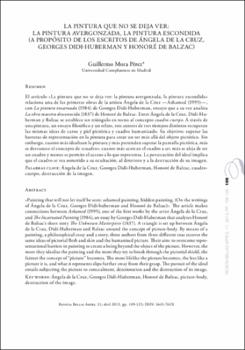La pintura que no se deja ver. La pintura avergonzada, la pintura escondida (a propósito de los escritos de Ángela de La Cruz, Georges didi-Huberman y Honoré de Balzac)
Autor
Mora Pérez, GuillermoFecha
2013Resumen
El artículo «La pintura que no se deja ver: la pintura avergonzada, la pintura escondida» relaciona una de las primeras obras de la artista Ángela de la Cruz ashamed (1995), con La pintura encarnada (1984) de Georges Didi-Huberman, ensayo que a su vez analiza La obra maestra desconocida (1837) de Honoré de Balzac. Entre Ángela de la Cruz, didi-Huberman y Balzac se establece un triángulo en torno al concepto cuadro-cuerpo. A través de una pintura, un ensayo filosófico y un relato, tres autores de tres tiempos distintos recuperan las mismas ideas de carne y piel pictórica y cuadro humanizado. Su objetivo: superar las barreras de representación en la pintura para crear un ser más allá del objeto pictórico. Sin embargo, cuanto más idealizan la pintura y más pretenden superar la pantallapictórica, más se desvanece el concepto de «cuadro»; cuanto más acercan el cuadro a ser, más se aleja de ser un cuadro y menos se permite el acceso a lo que representa. La persecución del ideal implica que el cuadro se vea sometido a su ocultación, al deterioro y a la destrucción de su imagen. Painting that will not let itself be seen: ashamed painting, hidden painting. (on the writings of Ángela de la Cruz, Georges didi-Huberman and Honoré de Balzac)». The article makes connections between Ashamed(1995), one of the first works by the artist Ángela de la Cruz, and The Incarnated Painting (1984), an essay by Georges didi-Huberman that analyses Honoré de Balzac’s short story The Unknown Masterpiece(1837). A triangle is set up between Ángela de la Cruz, Didi-Huberman and Balzac around the concept of picture-body. By means of a painting, a philosophical essay and a story, three authors from three different eras recover the same ideas of pictorial flesh and skin and the humanised picture. Their aim: to overcome representational barriers in painting to create a being beyond the object of the picture. However, the more they idealise the painting and the more they try to break through the pictorial shield, the fainter the concept of “picture” becomes. The more lifelike the picture becomes, the less like a picture it is, and what it represents slips further away from their grasp. The pursuit of the ideal entails subjecting the picture to concealment, deterioration and the destruction of its image.





